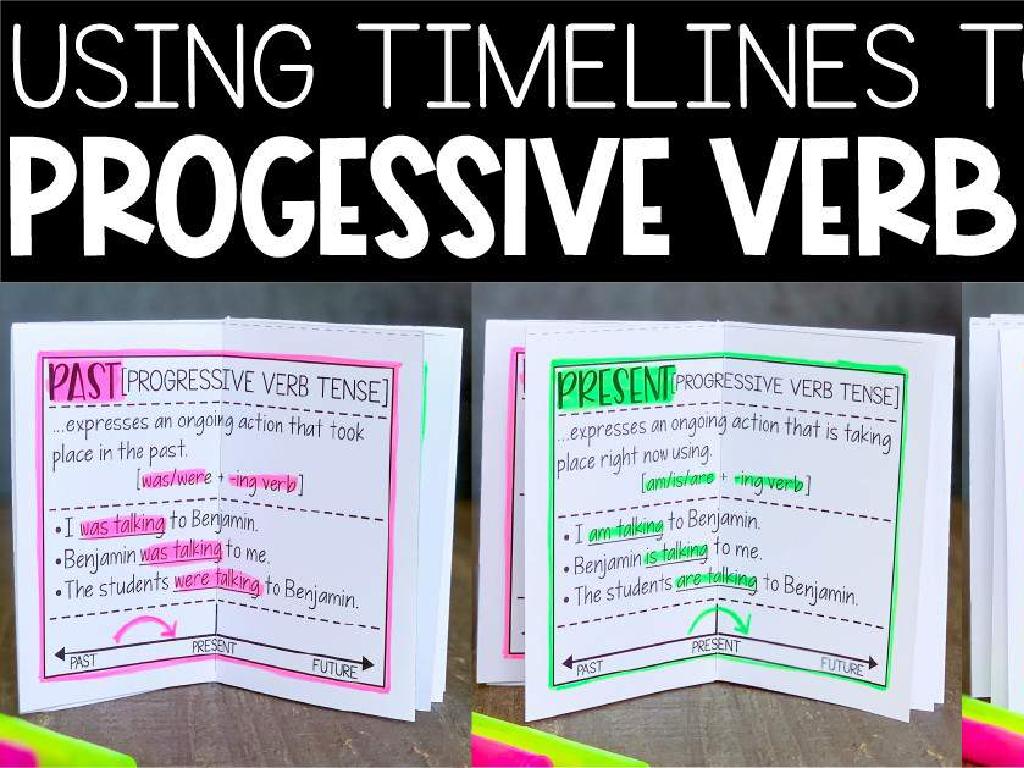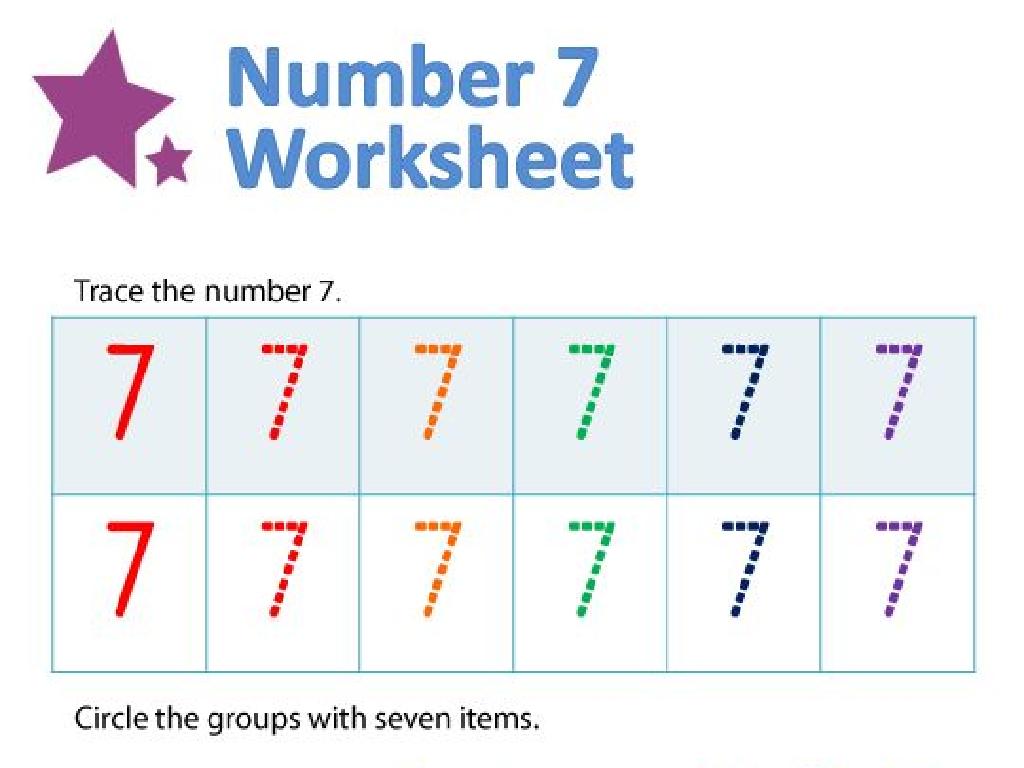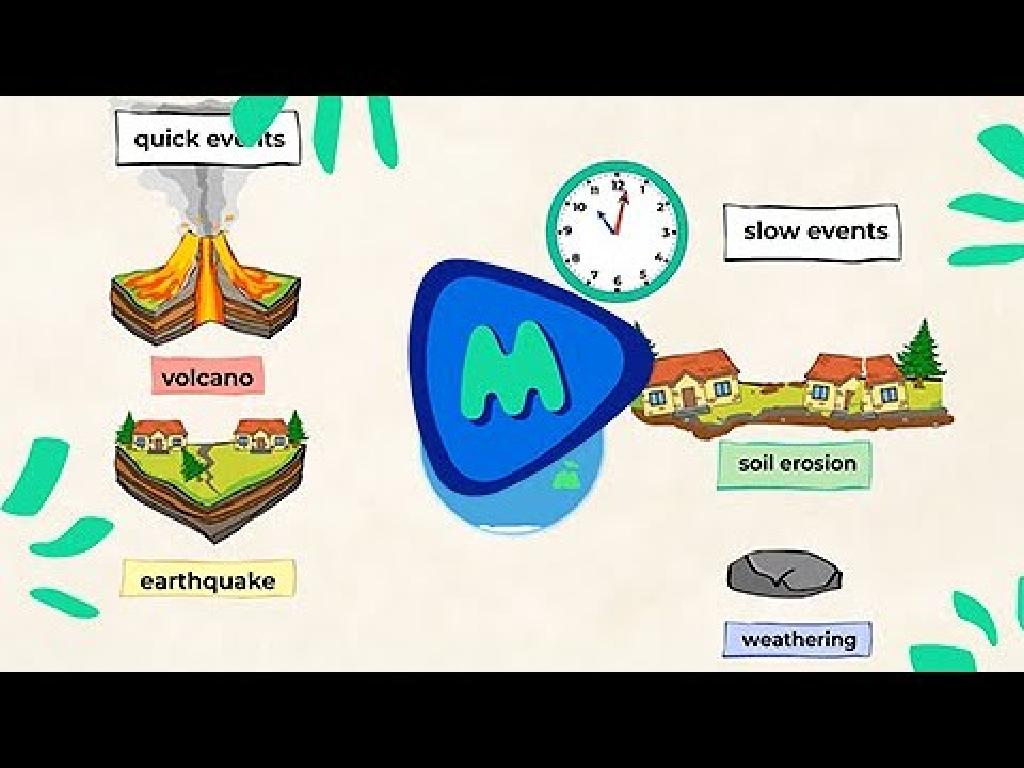Identify Helping Verbs
Subject: Language arts
Grade: Third grade
Topic: Verb Types
Please LOG IN to download the presentation. Access is available to registered users only.
View More Content
Discovering Helping Verbs
– Verbs are action words
– Helping verbs work with main verbs
– They ‘help’ the main verb show tense or possibility
– Examples: am, is, are, was, were
– ‘I am running’, ‘She is singing’, ‘They were dancing’
– Let’s find helping verbs together!
|
This slide introduces the concept of helping verbs to third-grade students. Begin by recapping what a verb is, emphasizing that verbs are words that show action or a state of being. Explain that helping verbs are special verbs that assist the main verb in a sentence to express actions more clearly. They help by changing the tense or showing possibility. Provide clear examples using common helping verbs like ‘am’, ‘is’, ‘are’, ‘was’, and ‘were’. Engage the class by asking them to find and use helping verbs in sentences. This activity will help them understand how helping verbs modify the main verb to provide more detail about the action.
Exploring Helping Verbs
– What are helping verbs?
– Verbs that assist the main verb to express action or state
– Helping vs. main verbs
– Main verbs can stand alone, helping verbs cannot
– Examples in sentences
– ‘Am’, ‘is’, ‘are’, ‘was’, and ‘were’ show time in sentences
– Practice identifying them
|
This slide introduces the concept of helping verbs to third-grade students. Begin by defining helping verbs as those that assist the main verb in a sentence to express an action or a state of being. Contrast helping verbs with main verbs by explaining that main verbs can stand alone as the action of the sentence, while helping verbs always accompany a main verb. Provide clear examples of helping verbs within sentences to illustrate their use, such as ‘I am running’ or ‘She was singing’. To reinforce learning, engage students with an activity where they identify helping verbs in sentences you provide. This will help them understand the role of helping verbs in the context of a sentence.
The ‘Be’ Helpers in Sentences
– Meet the ‘Be’ helpers: am, is, are, was, were
– These words work with main verbs to form a verb phrase.
– How ‘Be’ verbs support main verbs
– They show time and complete the action in a sentence.
– Finding ‘Be’ helpers in sentences
– Look for ‘am’, ‘is’, ‘are’, ‘was’, ‘were’ before main verbs.
– Practice with ‘Be’ helper verbs
– We’ll do fun activities to spot ‘Be’ helpers!
|
This slide introduces the concept of ‘Be’ helper verbs, which are forms of the verb ‘to be’ that assist the main verb in a sentence. Explain that these helpers are important for showing when an action is happening (present or past) and for making sentences complete. Provide examples of sentences using ‘Be’ helpers and encourage students to identify them. For instance, in the sentence ‘She is running,’ ‘is’ is the helper that supports the main verb ‘running.’ Engage the class with activities where they find and underline the ‘Be’ helpers in sentences from a story or worksheet.
The ‘Have’ Helpers in Action
– Meet ‘Have’, ‘Has’, ‘Had’
– Show possession with ‘have’ helpers
– ‘I have a pet dog’ shows I own a dog
– ‘Have’ helpers indicate completion
– ‘She has finished her homework’ means she’s done
– Practice spotting ‘have’ helpers
– Find ‘have’ helpers in sentences we read together
|
This slide introduces the ‘have’ helpers as an important component of helping verbs in English grammar. Students will learn that ‘have’, ‘has’, and ‘had’ can be used to show possession (something you own) and completion (something that has been finished). The practice activity will involve identifying these helpers within the context of sentences, reinforcing their understanding through application. Encourage students to think of their own examples of sentences using ‘have’, ‘has’, and ‘had’ to describe things they own or activities they have completed. This will help solidify their grasp of the concept through personal connection.
The ‘Do’ Helpers in Action
– Meet ‘Do’, ‘Does’, ‘Did’
– ‘Do’ helpers in questions
– They help ask questions: ‘Do you like apples?’
– Using ‘Do’ helpers in negatives
– They make sentences negative: ‘I do not like rain.’
– Activity: Find the ‘Do’ helpers
– Look for ‘do’, ‘does’, ‘did’ in sentences.
|
This slide introduces the ‘Do’ helper verbs (‘do’, ‘does’, ‘did’) and their role in forming questions and negatives. Explain that these helpers are used to ask about regular activities or to make statements negative. For the activity, provide students with sentences and ask them to identify and underline the ‘Do’ helpers. Encourage them to create their own sentences using these helpers. Possible activities: 1) Matching sentences with the correct ‘Do’ helper, 2) Filling in blanks with ‘do’, ‘does’, ‘did’, 3) Rewriting affirmative sentences into questions or negatives, 4) Creating a short dialogue using ‘Do’ helpers.
Modal Helping Verbs
– Learn about modals
– ‘Can’, ‘Could’, ‘Will’, ‘Would’, ‘Shall’, ‘Should’, ‘May’, ‘Might’, ‘Must’ are modals
– Modals affect verb meaning
– ‘Can’ shows ability, while ‘must’ shows necessity
– See modals in action
– ‘I can swim’ vs. ‘I must swim’
– Practice with modals
– Find sentences in books and underline the modals
|
This slide introduces modal helping verbs to third graders, explaining that these special verbs modify the main verb to add meaning about possibility, ability, or obligation. Provide examples of how each modal can change the meaning of a sentence. For instance, ‘can’ indicates ability, while ‘must’ indicates a necessity. Encourage students to think of situations where they might use each modal verb. As an activity, students can look for modal verbs in their favorite books and underline them, which will help reinforce their understanding of how modals function within sentences.
Let’s Practice Helping Verbs!
– Find helping verbs in sentences
– Look for words like ‘is’, ‘are’, ‘was’, ‘were’, ‘will’, ‘would’, ‘can’, ‘could’, etc.
– Pair up: Write sentences with helping verbs
– Work with a friend and be creative!
– Share your sentences with the class
– Practice speaking skills and learn from others
– Understand how helping verbs work
|
This slide is for a class activity focused on identifying and using helping verbs. Start by explaining what helping verbs are and how they assist the main verb in a sentence. Then, have students identify the helping verbs in given sentences. Next, students will pair up to create their own sentences using helping verbs, encouraging them to use their imagination and apply what they’ve learned. Finally, students will share their sentences with the class, which will help reinforce their understanding and provide an opportunity for public speaking practice. As a teacher, walk around to assist pairs as needed and prepare to highlight good examples from each pair during the sharing portion.
Class Activity: Helping Verb Hunt!
– Find helping verbs in a story
– Work together in small groups
– Circle the helping verbs you find
– Discuss the role of helping verbs
– How do they change the meaning of the main verb?
|
This interactive class activity is designed to help students identify and understand the function of helping verbs within sentences. Divide the class into small groups and provide them with a short story or a few sentences. Each group’s task is to find and circle all the helping verbs they can identify. After the hunt, lead a class discussion on how helping verbs support the main verb and alter its meaning. For example, ‘is jumping’ versus ‘was jumping’. Possible activities: 1) Each group could have a different story to increase the variety of examples. 2) Groups can create their own sentences using helping verbs. 3) Have a competition to see which group can find the most helping verbs. 4) Groups can act out sentences to demonstrate the difference in meaning with and without helping verbs.
Conclusion: Helping Verbs & Homework
– Recap on helping verbs
– Remember, helping verbs support the main verb!
– Homework: Craft a short story
– Use your imagination and write a fun tale
– Include 5 different helping verbs
– Can, have, will, are, be – try using these!
– Next class: Linking verbs!
|
As we wrap up today’s lesson, remind the students about the role of helping verbs in sentences. For homework, they should write a short story and creatively incorporate at least five different helping verbs to practice their understanding. Encourage them to think of actions in their story that need helping verbs. In the next class, we’ll review their stories to reinforce the concept and introduce linking verbs, which connect the subject with more information about the subject. Provide examples of helping verbs and encourage students to share their stories in the next class for a peer review session.






